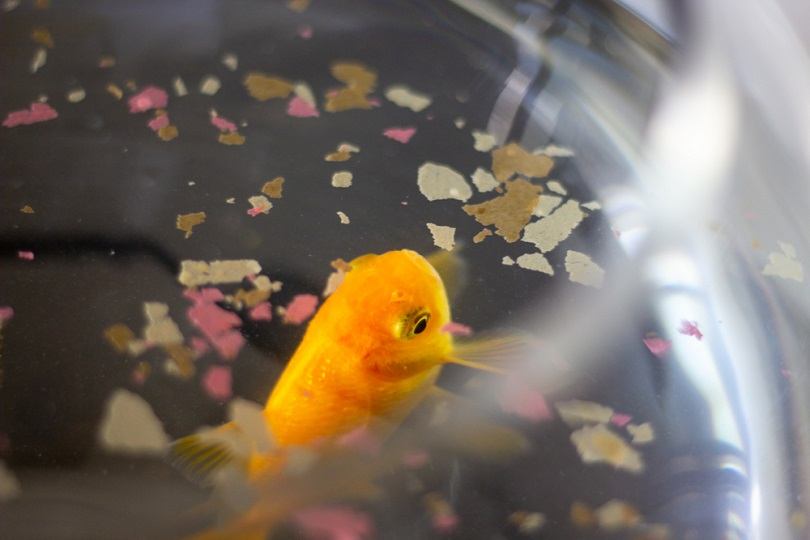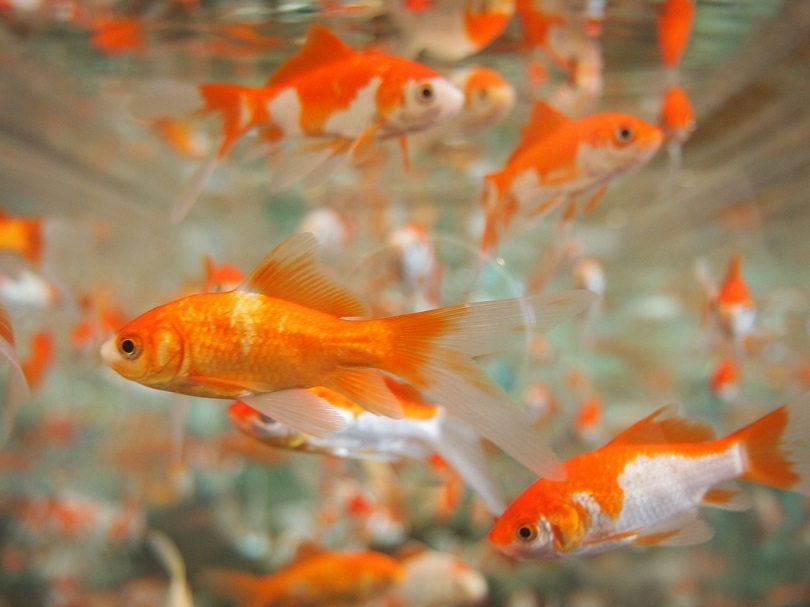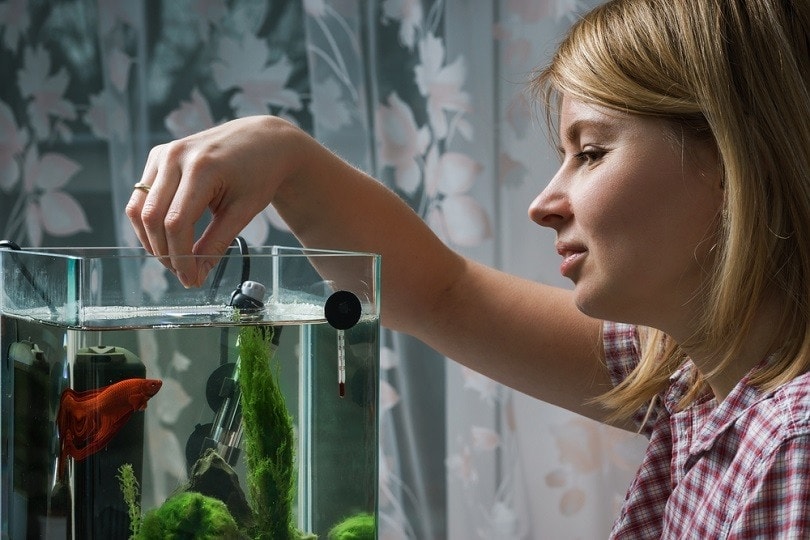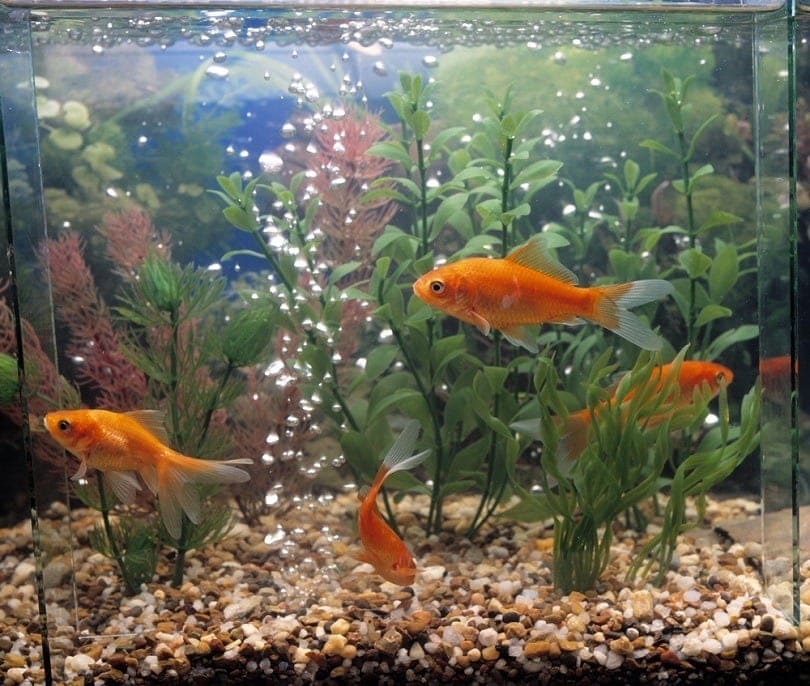How To Add Ammonia To Fish Tank
Information technology'south A Fish Affair is reader-supported. When you lot buy via links on our site, nosotros may earn an affiliate commission at no cost to you. Learn more.
Ammonia is a huge problem in planted tanks besides as normal fish tanks as well. In fact, it is highly poisonous to any and all living organisms in your fish tank.
It will quickly toxicant, swallow away at, and somewhen kill all of the plant and fish life in your aquarium. So, we are here today to help you figure out how to lower ammonia levels in your fish tank.

Table of contents
- What Is Ammonia?
- What Causes Ammonia In Fish Tanks?
- 1. Uneaten Fish Nutrient in the Aquarium
- ii. Decaying Plants
- 3. Excessive Fish Waste
- four. Improper Tank Filtration
- 5. A New Tank – The Nitrogen Cycle in an Aquarium
- 6. Your Tap Water
- How Does Ammonia Affect Fish?
- What Should Ammonia Levels Be In My Fish Tank?
- How To Lower Ammonia Levels In Fish Tank: seven Means
- 1. Changing The Water
- 2. Remove Waste product & Unwanted Organic Matte
- iii. Less Feeding
- 4. Healthy Bacteria
- 5. Lowering The pH Level
- six. More Aeration
- 7. Neutralizing Drops
- Signs Of Loftier Ammonia Levels In Fish Tank
- What Is The All-time Ammonia Remover For Aquariums?
- API AMMO-LOCK Ammonia detoxifier
- Commonly Asked Questions
- How To Lower Ammonia Levels In Fish Tank Naturally
- How Do You Care for Ammonia Poisoning In Fish?
- How Long Does It Take For Ammonia To Build Upwards In A Fish Tank?
- How Long Does It Take For Ammonia To Go Down?
- How Long Does It Take For Fish Nutrient To Plough Into Ammonia?
- Is .25 Ammonia Harmful To Fish?
- Conclusion
What Is Ammonia?
Ammonia is a colorless gas that has a very distinct smell. Ammonia is composed of both nitrogen atoms and hydrogen atoms, and it has the chemical symbol of NH3.
This is a naturally occurring substance that is produced by the human body, as well as in nature. It can occur in h2o, soil, air, and more.
Ammonia makes for a great cleaner, which is why information technology is used for many industrial cleaning applications, simply that said, it is too poisonous, especially if the ammonia level in your fish tank hits a certain corporeality.

What Causes Ammonia In Fish Tanks?

In that location are a diverseness of reasons why your fish tank might take high ammonia levels in it. If your aquarium has high ammonia levels, whatsoever of the following reasons may be to blame.
i. Uneaten Fish Food in the Aquarium

One of the biggest reasons as to why the ammonia level in your aquarium might be loftier is due to uneaten food. If uneaten nutrient remains in the tank for too long, it will brainstorm to rot and decompose.
As the uneaten food rots and decomposes, it creates and releases ammonia into the h2o.
Therefore, if y'all have an ammonia problem, feeding your fish less, cleaning the tank, and doing a water change to remove uneaten food can aid.
two. Decomposable Plants

Plants can also exist a cause of a high ammonia level in a fish tank. If your plants are non doing well, those plants may start to rot or decompose in the tank.
If you have rotting plants in your tank, merely like with uneaten fish food, those rotting plants will begin to create and release ammonia into the aquarium, which tin can then besides pb to excessive ammonia nitrite levels as well.
To solve this consequence, a water change can aid, but removing decomposable plant matter is the number one choice.
That said, if you take good intendance of your plants and take them in the proper h2o parameters, then this really shouldn't exist a problem.
iii. Excessive Fish Waste product

If y'all take a fully stocked fish tank, 1 that has plenty of fish in it, particularly if you feed them too much, they will create a lot of waste material.
Fish waste, or feces in other words, is a leading cause of an excess ammonia level in the fish tank. Fish waste product released a whole lot of this substance into an aquarium, and can rapidly lead to an ammonia problem.
In one case again, cleaning the tank and performing a h2o modify can help, only feeding your fish less and ensuring that you have a working filter will assist reduce ammonia levels in the tank the most, if this is the cause.
Many fish that eat a lot lead to excess waste product, and therefore a large time ammonia level.
4. Improper Tank Filtration

Your aquarium filter is the number one tool at your disposal to become rid of ammonia in the tank. Your filter is a big part of the aquarium nitrogen cycle, particularly the biological filtration aspect.
Benign bacteria that grow in the filter actually interruption downward ammonia in the tank by turning information technology into nitrite and nitrate.
If your filter is not upward to treatment the water volume in the tank, if you have many fish, if the filter is broken, if the biological media is former, or if you don't properly clean and maintain your filter, information technology can rapidly lead to this problem.
Excessive levels of ammonia can most always exist attributed to a lack of proper filtration in the tank.
To get rid of ammonia, cleaning your filter, replacing biological media, and ensuring that it is designed for your size of tank is crucial.
5. A New Tank – The Nitrogen Cycle in an Aquarium

The nitrogen cycle for aquarium is another large time actor here, and the nitrogen wheel is possibly the most of import thing to remove ammonia from the tank.
If yous have a new tank with new fish, the amount of beneficial bacterium in the tank volition be lower than they should be. It takes between three and half dozen weeks for these little organisms to multiply to the betoken where they tin can go rid of excessive levels of ammonia.
A new tank is always going to have backlog levels of ammonia until the nitrogen bicycle has completed a couple of times.
Therefore, to remove ammonia from the fish tank, waiting for a while for the cycle to become going is essential, and adding new fish to the aquarium before this is definitely not recommended.
Putting fish into a brand new tank like that will be a problem of its own, and yep, its due to the ammonia level.
6. Your Tap H2o

Yes, your tap water may also have ammonia in information technology, then before you use water from the tap, make sure to let it sit down for 24 hours.
Besides, if need be, brand certain to apply water conditioner and ammonia remover before adding the water into the tank.

How Does Ammonia Touch Fish?
Simply put NH3 is highly toxic to fish. It causes chemical burns on the skin and on the gills, and as it absorbs in to the body of the fish, it literally burns them from the inside out.
Information technology will burn interior tissue and organs, and end upwards causing mass organ failure, and eventually death.
What Should Ammonia Levels Be In My Fish Tank?

The level of ammonia in your fish tank should be as low as humanly possible. Fish are very sensitive to this stuff and even small amounts tin cause a trouble.
Always make certain to examination the water to ensure that the levels are acceptable. 0 ppm is best, and recall that anything over 1 ppm (function per 1000000), can be harmful to fish.
Therefore, the less there is, the better, and all-time is if there is none at all.

How To Lower Ammonia Levels In Fish Tank: 7 Ways
Now that we have covered what is ammonia in a fish tank let's now look at 7 means of reducing ammonia levels;
i. Irresolute The H2o

I of the easiest, fastest, and about constructive ways of decreasing ammonia levels in the water of your fish tank is to simply supercede the old and contaminated water with fresh h2o.
To be off-white, regular fractional h2o changes is something that you should exist doing on a weekly footing anyhow. If you see that there is too much ammonia in the water, you can always perform the partial water changes more often.
One way to know that y'all aren't doing these water changes often plenty, is when you do them and the substrate (we have reviewed some good substrates over at this commodity), when stirred up, causes cloudiness in the water.
This is a sign that you aren't doing the water changes oft plenty because at that place is conspicuously a lot of waste sunk in the substrate. Simply remove well-nigh 30 percentage of the water with a scoop or small bucket, while existence conscientious not to agitate the fish or destroy constitute life.
Put the same amount of fresh h2o in a bucket with some dechlorinating agents, let information technology sit for a few hours, make certain the temperature is roughly the same as the current tank water, and slowly pour it dorsum in.
In terms of numbers, this process should realistically have drop ammonia levels past 30%, or fifty-fifty more than if you change more water. Go along in listen, information technology is non recommended that you always alter more than than xxx% of the h2o at once, or else you are putting the wellness of your fish at serious risk.
2. Remove Waste & Unwanted Organic Matte 

Since rotting food, fish waste material, and onetime plants can all cause ammonia, another easy solution to your ammonia trouble is to remove the things creating or releasing it.
Of course y'all aren't going to remove the fish from the tank, because they are the whole signal of having an aquarium, only there are several other things that you can do for sure.
Use a scoop or gravel filter (this one is good) to clean the substrate of any and all waste, uneaten food, and decaying plant matter.
This volition go a long way in lowering ammonia levels. As well, yous can clean out the filter in your tank to make it more efficient at its job.
3. Less Feeding

If your fish leaves behind a lot of uneaten food, or if y'all realize that your fish produce an excessive quantity of waste when they shouldn't be, information technology might be time to starting time feeding your fish less.
Since both uneaten food and fish waste material release ammonia, feeding them no more than than the required amount may help to reduce ammonia levels.
4. Salubrious Leaner

Some other thing that you tin try doing in order to lower the ammonia levels in your fish tank is to innovate some healthy and beneficial bacteria into the equation.
Y'all can try adding some new fish into the water, adding gravel from an erstwhile tank, or become yourself a proficient filter with biological filtering, all of which will serve to add new bacteria into the water.
These bacteria volition and so intermission down the ammonia into nitrites, and eventually into nitrates. Both nitrites and nitrates are however harmful to your fish, simply not nigh as much as ammonia.
v. Lowering The pH Level 

When your water is basic, or higher up than 7.0 on the pH scale, ammonia tends to exist present in higher concentrations considering it does not break down equally well is basic water. You can get to your local pet store and buy chemic pH adjusters to lower the pH levels in your fish tank.
Just beware that your fish practice accept a specific pH range which they need to live, then that is something yous volition need to take into consideration.
Lowering the pH levels in your fish tank will not actually remove the ammonia from the water, but information technology volition make it less potent and dangerous to your fish.
Yous can actually also try calculation new gravel into the tank as opposed to coral or sand. Coral and sand will release calcium into the water, which will in turn crusade a rise in pH levels.
6. More Aeration

Having a lack of aeration in the water is bad not only for your fish as they effort to breathe, but also because it allows ammonia to stay present in the h2o much easier. Ammonia is a dissolved gas, so a lack of aeration can make it stay in the water.
On the other manus, increasing the aeration volition increase the rate at which the ammonia diffuses into the air above the water, thus decreasing the levels of it in the fish tank. The merely way to really do this is by ownership an air pump.
If yous don't accept a pump and so nosotros accept covered some other tips here.
7. Neutralizing Drops

The final thing that you can practice in order to lower ammonia levels in your fish tank is to use neutralizing drops.
These will non actually remove the ammonia from the h2o, just they will render its toxic effects non-real.

Signs Of High Ammonia Levels In Fish Tank
In that location are a few mutual signs to look out for such every bit;
- Appetite loss
- Gills inflamed (pink effectually gills)
- Eyes inflamed
- Labored breathing
- Fish surfacing to the top more than normal
If you are in doubt then you should definitely do a exam asap, y'all can either use test strips or a liquid test kit (we think liquid ones are better personally).
What Is The Best Ammonia Remover For Aquariums?
API AMMO-LOCK Ammonia detoxifier

This is one of the most highly rated ammonia removers out there, and it's said to reduce ammonia in both water from the tap and your tank akin.
It can be used in both saltwater and freshwater tanks. All you take to practice is cascade it into the aquarium according to the instructions, and repeat the process every ii days until there is no ammonia in the tank. Information technology's fast, simple, and very effective.
Pros
- Very constructive.
- Like shooting fish in a barrel to use.
- A little goes a long manner.
- Clear instructions.
Cons
- Excessive use is not salubrious for fish.
Check pricing at Amazon

Commonly Asked Questions
How To Lower Ammonia Levels In Fish Tank Naturally

There are indeed various ways to naturally lower the levels of ammonia in a fish tank. Here is a quick overview of the most effective methods.
- Do a partial h2o change of roughly 30%. This should automatically remove xxx% of the ammonia content in the water. However, exist careful non to modify more than 30% of the h2o per calendar week, as this can cause problems in itself.
- Scoop out any and all organic matter that should not be present in the aquarium. This includes rotting plant affair, one-time food, fish waste, and dead fish likewise.
- Reduce the amount and frequency of food you lot give your fish. The less nutrient they get, the less waste product they produce, and this volition therefore lower ammonia levels.
- Introduce higher quantities of beneficial bacteria into the h2o which piece of work to break ammonia down rapidly.
- Slightly increase the aeration and oxygenation levels in the tank water.
How Practice You Treat Ammonia Poisoning In Fish?
What you lot tin do here is to forestall ammonia from building up in a fish tank in the starting time place. This is the near constructive method.
However, unfortunately, at that place is absolutely no cure for ammonia poisoning in fish, which makes prevention all that much more important.
How Long Does It Take For Ammonia To Build Up In A Fish Tank?

Generally speaking, it is going to take anywhere betwixt 30 and 45 days for ammonia to build upward in a fish tank to levels which tin can harm and kill fish. This is pretty fast all things considered.
Of course, this is going to depend on several factors, including the corporeality of fish in the tank, the frequency and amount of feeding, if yous have a good filtration organisation, how much oxygen is in the water, and how many benign bacteria yous have nowadays.
If conditions are non ideal in the least, it may take as little as 2 weeks for ammonia to build to levels that can be super harmful to fish.
How Long Does It Take For Ammonia To Go Downwardly?
If you are experiencing an ammonia spike in your aquarium, it will take upward to six weeks for it to go dorsum down. Now, this does depend on the quality of the nitrogen cycle in your tank.
If you take enough of beneficial bacteria in your tank that are breaking the ammonia downwardly, information technology may take but two to 4 weeks, but if you don't have benign bacteria, information technology volition have much longer, or it might not go downwards at all.
This procedure can be quickened by adding more beneficial leaner to the water and by doing regular partial water changes.
How Long Does It Take For Fish Food To Plough Into Ammonia?

This is another matter which depends smashing on tank conditions, mainly the amount of benign bacteria in the water.
Generally speaking, between the procedure of decomposition and the bacteria breaking food down, it will accept about 2 to 4 days for uneaten fish food to turn into ammonia.
Is .25 Ammonia Harmful To Fish?
Technically speaking, any amount of aquarium ammonia can be harmful to fish. You should do everything in your power to prevent any and all ammonia from building up in the aquarium.
Ammonia levels of 0 parts per million are best. 1 part per million of ammonia in the water is even so acceptable, although definitely non ideal. Annihilation over two parts per million has very existent potential to damage your fish.
And so, realistically, 0.25 ppm is non astringent, and it should not impairment your fish, just it is nevertheless worse than no ammonia at all.

Conclusion
Simply think that ammonia, even in the smallest of quantities, can end up making your fish sick and killing them very quickly and so information technology'due south important to know non just how to identify but too how to get rid of ammonia which hopefully nosotros have helped you to do so.
It is important to test your water for ammonia on a regular basis, and if there is too much of it, use any or all of the above methods to rectify the situation.
Featured Epitome Credit: mariait, Shutterstock
How To Add Ammonia To Fish Tank,
Source: https://www.itsafishthing.com/how-to-lower-ammonia-levels-in-fish-tank/
Posted by: freemanyouripasted.blogspot.com


0 Response to "How To Add Ammonia To Fish Tank"
Post a Comment